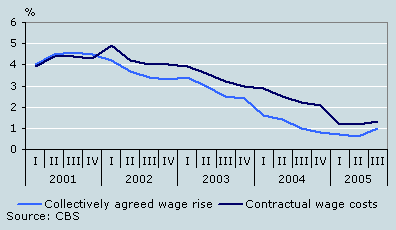Collectively agreed wage rises up again

Collectively agreed wage rates in the Netherlands were 1.0 percent higher in the third quarter of this year than in the same quarter last year. In the second quarter this increase was still only 0.6 percent. This has put an end to more than three years of nearly continuous decrease in the collectively agreed wage rises. With 1.7 percent, business services had a relatively large increase in negotiated wages.
Wage rises still small
Collectively agreed wage rises reached their highest point for the last twenty years in the third quarter of 2001, at 4.6 percent. Compared with this, the increase of 1.0 percent in the third quarter of 2005 is still small. The results for the third quarter are based only on collective agreements which have now been concluded, i.e. 54 percent of the total number of agreements.
Collectively agreed wage rises per quarter

Wage costs rise faster than wages
Contractual wage costs rose by 1.3 percent in the third quarter, bringing the difference between the rise in wage costs and the rise in wages to 0.3 percent in this quarter. The difference has not been this small in the last three years. In 2004 it was still as much as 1.2 percent.
Development of collectively agreed wages and contractual wage costs

Largest increase in business services
There are large differences in collectively agreed wage rises between the various sectors of industry. Wages rose by most in the business services sector: 1.7 percent. In the computer branch in particular wages roses substantially, by 3.5 percent. Agreed wages in construction, too, rose by more than average: 1.4 percent.
Wage rises by sector of industry, third quarter 2005

Wages rates down in hotels and restaurants
The smallest wage increases were reported in trade, transport and communication. In the hotel and restaurant sector wages, including special payments even decreased, by 0.2 percent. Excluding special payments the agreed wage level in this sector did rise: by 0.2 percent. The difference is the result if the discontinuation of a single payment bonus for employees in hotels and restaurants.
Monique Hartog